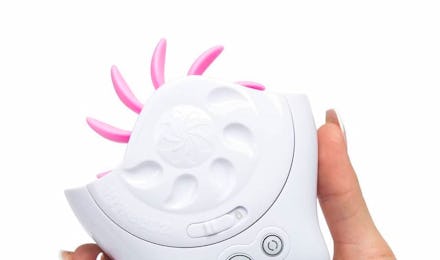How sex toys finally evolved beyond the big fake penis

Sex toys have basically been around since humans starting making tools. Most of the oldest were modeled after — yes, you guessed it — dicks. Archaeologists found a 28,000-year-old bronze dildo in China, and the Ancient Greeks were making them out of bread (insert yeast infection joke here). Our cultural perspectives on gender and sex are comstantly in flux, and as a result, sex toys have evolved a lot since their first crude introduction.
Starting in the late 19th Century, sex toys starting vibrating, which suggests that people were starting to catch on to the fact that women's pleasure wasn't always about the D. In the 20th Century, toys starting getting more individualized. Cynthia Plaster Caster famously made toys out of legendary rock phalluses. Now you can cast your own dildo out of your favorite dick in the privacy of your own home with a kit (whether it's legendary or not). You can also mold a vagina, but you’ll have to settle for the externally visible vulva and labia.
A lot of sex toys mimic human genitalia. Our anatomy hasn’t changed much since ancient times, but our ideas have. The assumed marriage of gender identity and genitals has weakened. As our attitudes about gender have gotten more fluid, sex toys have gotten also more inclusive and less obviously genital. Wild Flower, makers of the Enby, make a non-gendered silicone toy that promises joy to every body and any body. Although it is meant to stimulate genitals across the gender spectrum, it bears no resemblance to any I’ve ever seen. It looks kind of like an alien manta ray.
We can look at toys like the Enby as marketplace predictors of the fact that gender fluidity is becoming more socially acceptable.
In an attempt to embrace sexual accessories that are for the people and by the people, erotic toy company LoveHoney has, for the past few years, been crowdsourcing the sex-loving public to design their own fantasy toys. The winner gets to see their design come to life and to market. The 2020 contest is called “Future Sex 2030,” and it invites folks to imagine what the future of pleasure looks (and feels) like. “This competition opens the door for almost anyone to shape the future of sexual happiness,” Bonny Hall, director and judge of the contest, said in a press release.
The contest offers a $5,000 cash prize and, more impressively, a chance to shape the future of sexual pleasure. If past winners are any indication, the future of sex looks is going to be a lot more interesting than its past was. One of my favorite past toy design winners is the Sqweel, a disc of rotating tongues that is simultaneously titillating and a bit surreal.
Sex toys are like material proof of the ways attitudes about sex and gender change. A lot of times, sex toys seem to be ahead of the social curve in terms of accepting sexual and gender minorities. We can look at toys like the Enby as marketplace predictors of the fact that gender fluidity is becoming more socially acceptable. But toys sometimes follow cultural trends, too. There was an upsurge in the popularity of BDSM toys after Fifty Shades of Gray came out. This will go down as the chapter in pop culture in which we learned that trying to “pumpkin spice” our sex toys can be dangerous, as there was also, unfortunately, a corresponding spike in sex toy related injuries.
Most sex toys aren’t dangerous (do read this, though, if you use anything Bluetooth compatible). They can be, in fact, crucial boons to helping us understand our desires and identities. For example, I sometimes I see a toy and realize that it embodies a fantasy that I didn’t have words for. They tap into something that I didn’t know I was allowed to want. “People who are selling sex toys are typically sex positive, but they have to appeal to the mainstream,” says Dulcinea Pitagora, a New York City-based psychologist and sex researcher. “They’ve often been wanting to make new kinds of toys but are holding back because they need to appeal to the masses.”
When you see these new toys being made, she tells me, their concepts aren't necessarily new to the makers. They’ve just been waiting for a green light — an indication that the masses are ready. “Sexual knowledge has to reach a tipping point before we feel comfortable admitting that we want it, saying it out loud or wanting to buy it,” she says.